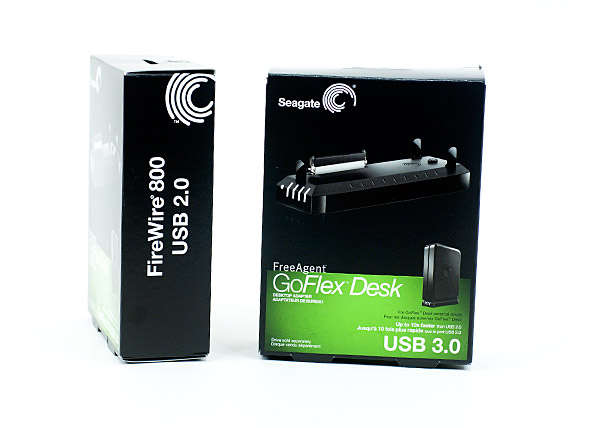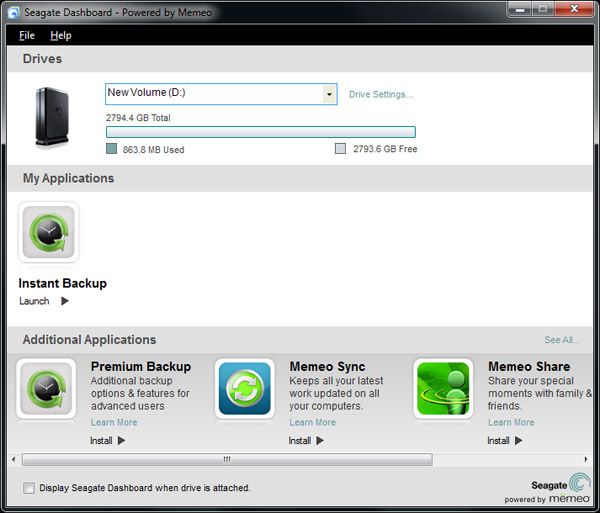The World's First 3TB HDD: Seagate GoFlex Desk 3TB Review
by Anand Lal Shimpi on August 23, 2010 12:39 AM EST- Posted in
- Storage
- Seagate
- HDDs
- GoFlex Desk
The GoFlex Desk
After putting the drive back together I decided to look at the product for what it is: an external 3.5” drive enclosure.
Seagate does nothing to hide the fact that this is a standard SATA drive in an enclosure. The SATA data and power connectors are clearly visible on the base of the enclosure. While you can plug a SATA power cable directly into the drive, the enclosure prevents you from sticking a SATA data cable in there - not without trimming away part of the plastic surrounding the cable’s SATA connector at least.

To mount the GoFlex Desk drive you just line it up with the dock and push down - the drive snaps into place. With a driver installed the dock can display how much of the drive is in use via a set of LEDs. These can be turned off in software.
The GoFlex Desk 3TB kit comes with a USB 2.0 dock ($350). You can buy the drive itself (in its GoFlex Desk enclosure) for $320.

The docks aren’t cheap, the basic USB 2.0 dock will set you back $30, while the USB 3.0 and FireWire 800/USB 2.0 docks are $40 and $50 respectively. And of course Seagate doesn’t make a dock with all three connections, the closest you can get is the FireWire 800 dock which has a USB 2.0 port on it as well.

The docks all use the same AC adapter. Power consumption at idle is around 10W, and the highest I saw under load was 14.3W.
There’s a fairly high performance 3.5” drive contained within so it’s not silent. I measured sound pressure in a room that measured 39.6 dB(A) with everything off:
| Sound Comparison | |||||
| Measured 1" Away | Measured 5" Away | ||||
| Off | 39.4 dB(A) | 39.4 dB(A) | |||
| Idle | 46.0 dB(A) | 40.7 dB(A) | |||
| Random Writes | 49.0 dB(A) | 41.0 dB(A) | |||
If you’re using a well designed notebook with its fans spun down, the GoFlex Desk is audible. If you’ve got another desktop or something else running in your room, you won’t notice the drive.
The drive ships with three pieces of software on it: Seagate’s Dashboard, Memeo Backup and Trial software, and a Mac OS X NTFS driver.

The Dashboard gives you basic info about your drive. You can control the LED lights on the GoFlex Desk dock - either keep them on or turn them all off.

The Memeo Instant Backup software is pretty basic. When configured it runs in the background and will automatically backup all non-system or program files. In other words it copies your documents, pictures, music and downloads but it won’t back up your OS, logs, or installed applications.

The backup happens automatically whenever files are saved/added. There’s a CPU usage penalty when this happens of course. Memeo Instant Backup uses around 11% of my quad-core Core i7 975 while backing up on the fly. It’s not an issue on a high end system, but lower end and single core machines for sure will have issues with the auto backup.
The final piece of software is nice for users who have both Macs and PCs. By default Macs can’t write to NTFS formatted volumes - they are read only under OS X. Seagate ships Paragon NTFS for Mac OS X v8.0.0 with the GoFlex Desk, normally $40, for free. Paragon NTFS lets you write to NTFS partitions as seamlessly as you’d write to a HFS+ partition in OS X. Just install the driver, reboot, activate, reboot once more and you’re good to go. There’s no performance impact vs. writing to HFS+ partitions.

You can also apparently activate it on multiple computers, so you can use it if you’ve got a Mac/PC household with multiple Macs.










81 Comments
View All Comments
zdzichu - Monday, August 23, 2010 - link
In first performance table you switched results for SATA and USB3.0 of 3TB drive.oc3an - Monday, August 23, 2010 - link
The maximum integer which can be represented with 32 bits is 4294967295 i.e. 2^32 - 1 which allows for 4294967296 values. The article is worded incorrectly.mino - Monday, August 23, 2010 - link
"...so the largest partition you can have in a MBR partitioned drive is 4294967296 * 512-bytes or 2,199,023,255,552 bytes..."Are you sure that is an incorrect wording?
mino - Monday, August 23, 2010 - link
BIOS does support booting from GPT.It is the Windows boot loader that cannot boot from GPT on BIOS systems.
As a matter of fact I am writing this from Gigabyte 780G board running Ubuntu 10.04 on top of GPT(on top of LVM on top of MD on top of GPT).
yuhong - Monday, August 23, 2010 - link
To be more precise, all that BIOS does is read the first sector of the drive, check for the signature at the end, and if it matches, then it jumps to the real mode x86 code at the beginning. It is actually partition scheme agnostic. Now some BIOSes are not quite partition scheme agnostic and will rely on the contents of the first sector being in the MBR format, luckily GPT support a protective MBR.baker269 - Monday, August 23, 2010 - link
I would love to see what the Ethernet speeds are like. Not that great I would guess since it's not a true NAS, but still would be nice.mindless1 - Monday, August 23, 2010 - link
?? It doesn't have an ethernet interface does it? Speeds would be similar enough to any current-gen 7200 RPM drive already in a system on your LAN.baker269 - Tuesday, August 24, 2010 - link
From the forth paragraph of the article."The drives themselves are standard 3.5” hard drives in a plastic enclosure designed to mate with GoFlex Desk adapters that add USB 2.0, USB 3.0, FireWire 800 or Ethernet connectivity to the drive."
It"s not as easy as just plugging in a hard drive with a RJ45 to a router, there needs to be some kind of CPU in between the two. NAS performance through Ethernet varies greatly.
derkurt - Monday, August 23, 2010 - link
Is it such a big deal that Windows doesn't boot from GPT drives if the BIOS is not EFI-capable? Whoever spends 400+ USD on a drive probably just needs lots of storage space for plain data. It's unlikely that there is no fast boot drive present in any system this drive is plugged into. Actually, since the first expansive 3 TB drives are bought by enthusiasts, chances are that the customers are already using an SSD as a boot drive.That said, in a realistic setting for a performance workstation with Windows 7 x64 installed on a 80+ GB SSD, there won't be a problem. You can connect the drive to the internal SATA connector, partition it with GPT and start using it, while your BIOS doesn't need to know anything about EFI or GPT. The heat issues might also look better when using the drive internally.
I don't understand why Seagate is holding back with selling the internal model. An estimated 95% of users will never even try to boot from it, and for the rest (who do want to boot from it but don't know about the 2+ TB issues), there could be a red warning note inside the box explaining the juicy details. After all, those who spend such an amount of money on a hard drive are not exactly the kind of people who have no clue about hard drives at all.
dryloch - Monday, August 23, 2010 - link
One of Seagates biggest advantages has been that their external hard drives come with a 5 year warranty. Why would they go to a two year warranty on the most expensive drive they sell? If anything they should have at least gone with three years. If they don't even trust this drive then I sure won't. I'll be waiting for Western Digital to have their drive out.